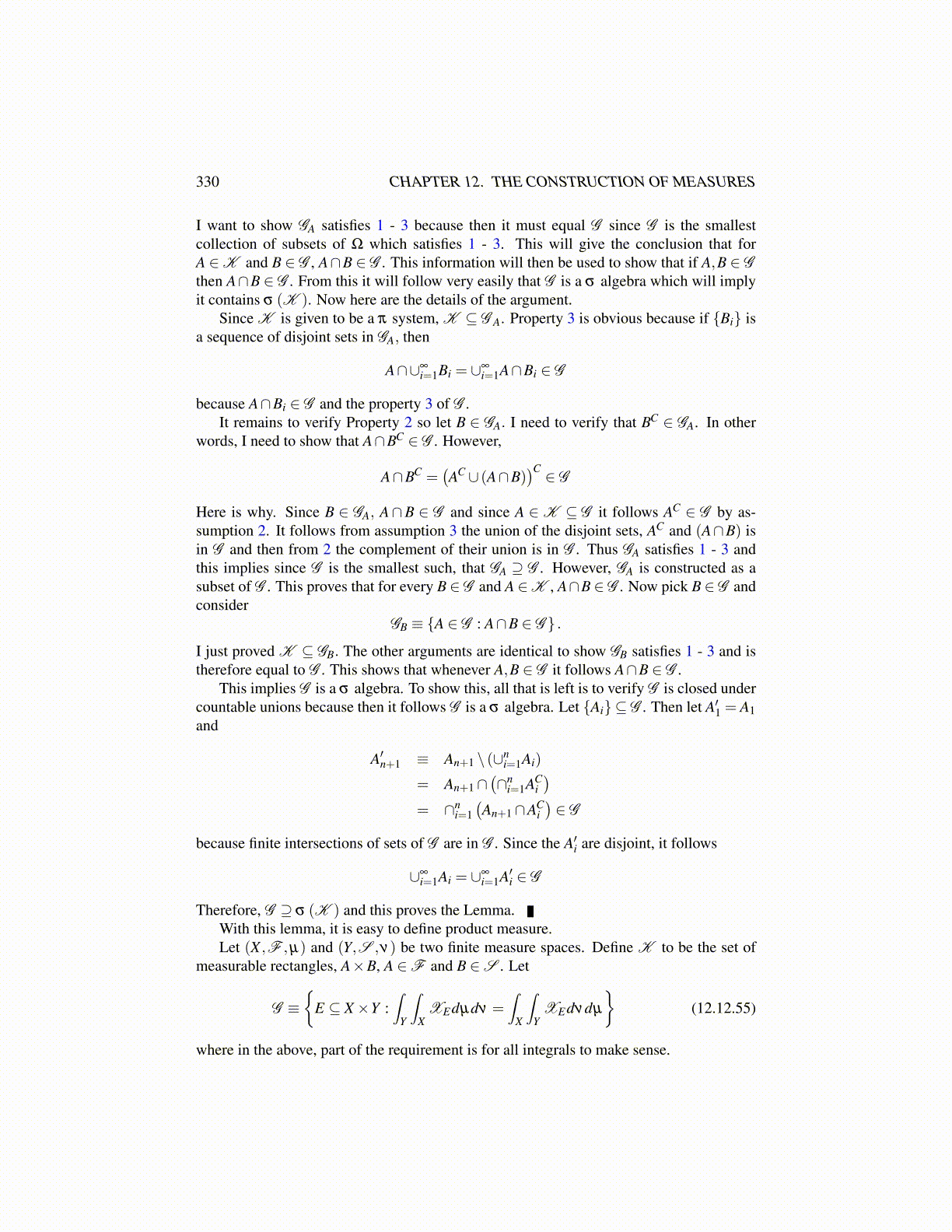
330 CHAPTER 12. THE CONSTRUCTION OF MEASURES
I want to show GA satisfies 1 - 3 because then it must equal G since G is the smallestcollection of subsets of Ω which satisfies 1 - 3. This will give the conclusion that forA ∈K and B ∈ G , A∩B ∈ G . This information will then be used to show that if A,B ∈ Gthen A∩B ∈ G . From this it will follow very easily that G is a σ algebra which will implyit contains σ (K ). Now here are the details of the argument.
Since K is given to be a π system, K ⊆ G A. Property 3 is obvious because if {Bi} isa sequence of disjoint sets in GA, then
A∩∪∞i=1Bi = ∪∞
i=1A∩Bi ∈ G
because A∩Bi ∈ G and the property 3 of G .It remains to verify Property 2 so let B ∈ GA. I need to verify that BC ∈ GA. In other
words, I need to show that A∩BC ∈ G . However,
A∩BC =(AC ∪ (A∩B)
)C ∈ G
Here is why. Since B ∈ GA, A∩B ∈ G and since A ∈K ⊆ G it follows AC ∈ G by as-sumption 2. It follows from assumption 3 the union of the disjoint sets, AC and (A∩B) isin G and then from 2 the complement of their union is in G . Thus GA satisfies 1 - 3 andthis implies since G is the smallest such, that GA ⊇ G . However, GA is constructed as asubset of G . This proves that for every B ∈ G and A ∈K , A∩B ∈ G . Now pick B ∈ G andconsider
GB ≡ {A ∈ G : A∩B ∈ G } .
I just proved K ⊆ GB. The other arguments are identical to show GB satisfies 1 - 3 and istherefore equal to G . This shows that whenever A,B ∈ G it follows A∩B ∈ G .
This implies G is a σ algebra. To show this, all that is left is to verify G is closed undercountable unions because then it follows G is a σ algebra. Let {Ai} ⊆ G . Then let A′1 = A1and
A′n+1 ≡ An+1 \ (∪ni=1Ai)
= An+1∩(∩n
i=1ACi)
= ∩ni=1(An+1∩AC
i)∈ G
because finite intersections of sets of G are in G . Since the A′i are disjoint, it follows
∪∞i=1Ai = ∪∞
i=1A′i ∈ G
Therefore, G ⊇ σ (K ) and this proves the Lemma.With this lemma, it is easy to define product measure.Let (X ,F ,µ) and (Y,S ,ν) be two finite measure spaces. Define K to be the set of
measurable rectangles, A×B, A ∈F and B ∈S . Let
G ≡{
E ⊆ X×Y :∫
Y
∫X
XEdµdν =∫
X
∫Y
XEdνdµ
}(12.12.55)
where in the above, part of the requirement is for all integrals to make sense.